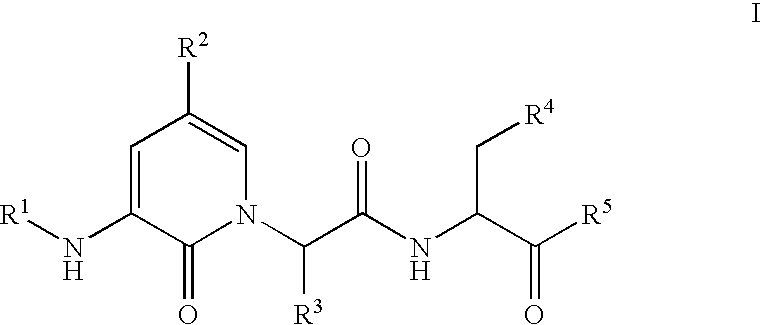Caspase inhibitors and uses thereof
a technology of caspase inhibitors and inhibitors, applied in the field of medicinal chemistry, can solve the problems of undesirable pharmacological properties of peptide inhibitors, poor oral absorption, and not always reflecting the effect of cellular models
- Summary
- Abstract
- Description
- Claims
- Application Information
AI Technical Summary
Benefits of technology
Problems solved by technology
Method used
Image
Examples
example 1
(S,S)-3-[2-(3-Acetylamino-2-oxo-2H-pyridin-1-yl)-butyrylamino]-4-oxo-5-(2,3,5,6-tetrafluoro-phenoxy)-pentanoic acid
[0167]
Method A:
(S)-2-(3-Benzyloxycarbonylamino-2-oxo-2H-pyridin-1-yl)-butyric acid tert-butyl ester
[0168]
[0169]To a cooled (0° C.) solution of (R)-tert-butyl hydroxybutyrate (1.03 g, 6.43 mmol) in dichloromethane (25 mL), was slowly added 2,6-lutidine (1.38 g, 12.9 mmol) and then trifluoromethanesulfonic anhydride (3.45 g, 12.2 mmol). The resulting mixture was stirred at 0° C. for 1 hour, then partitioned between tert-butylmethyl ether (150 mL) and an aqueous solution of 1M HCl (30 mL). The organic layer was washed with brine (30 mL), dried (sodium sulfate), filtered and concentrated to afford the triflate as a light brown oil.
[0170]To a solution of (2-oxo-1,2-dihydro-pyridin-3-yl)-carbamic acid benzyl ester (P. Warner et al., J. Med. Chem., 37, 19, 1994, 3090-3099)(1.73 g, 7.07 mmol) in dry THF (60 mL) was added sodium hydride (60% dispersion, 257 mg, 6.43 mmol) and th...
example 2
(S,S)-4-Oxo-3-[2-(2-oxo-3-propionylamino-2H-pyridin-1-yl)-butyrylamino]-5-(2,3,5,6-tetrafluoro-phenoxy)-pentanoic acid
[0183]
[0184]Prepared from (S)-2-(3-Amino-2-oxo-2H-pyridin-1-yl)-butyric acid tert-butyl ester and propionic anhydride according to methods C-G; white solid; IR (solid) 1584, 1642, 1662, 1717, 1749 cm−1; 1H NMR (400 MHz, d6-DMSO) δ 0.78 (3H, t), 1.04 (3H, t), 1.88-2.11 (2H, m), 2.43 (2H, q), 2.59 (1H, d), 2.75 (1H, dd), 4.61 (1H, m), 5.18-5.29 (2H, 2 dd), 5.40 (1H, m), 6.29 (1H, t), 7.37 (1H, d), 7.58 (1H, m), 8.22 (1H, d), 8.91 (1H, d), 9.08 (1H, s), 12.50 (1H, br s); 19F NMR (376 MHz, d6-DMSO, proton-decoupled) δ−140.6, −140.8, −141.1, −156.8, −157.0; M+H 530.2, M−H 528.3.
example 3
(S,S)-3-[2-(3-Butyrylamino-2-oxo-2H-pyridin-1-yl)-butyrylamino]-4-oxo-5-(2,3,5,6-tetrafluoro-phenoxy)-pentanoic acid
[0185]
[0186]Prepared from (S)-2-(3-Amino-2-oxo-2H-pyridin-1-yl)-butyric acid tert-butyl ester and butyryl chloride according to methods C-G; beige solid; IR (solid) 1659, 1645, 1509, 1490 cm−1; 1H NMR (400 MHz, d6-DMSO) δ 0.76-0.80 (3H, m), 0.88 (3H, t), 1.53-1.58 (2H, m), 1.88-1.93 (1H, m), 2.01-2.09 (1H, m), 2.37-2.41 (2H, m), 2.59 (1H, dd), 2.70-2.81 (1H, m), 4.59-4.63 (1H, m), 5.20-5.25 (2H, m), 5.38-5.50 (1H, 2×m), 7.36-7.38 (1H, m), 7.55-7.61 (1H, m), 8.21-8.23 (1H, m), 8.61-8.92 (1H, 3×d), 9.06-9.10 (1H, m), 12.49 (1H, br s); 19F NMR (376 MHz, d6-DMSO, proton-decoupled) δ−140.6, −141.1, −156.9, −157.0; M+H 544.3, M−H 542.3.
PUM
| Property | Measurement | Unit |
|---|---|---|
| temperature | aaaaa | aaaaa |
| concentration | aaaaa | aaaaa |
| concentration | aaaaa | aaaaa |
Abstract
Description
Claims
Application Information
 Login to View More
Login to View More - R&D
- Intellectual Property
- Life Sciences
- Materials
- Tech Scout
- Unparalleled Data Quality
- Higher Quality Content
- 60% Fewer Hallucinations
Browse by: Latest US Patents, China's latest patents, Technical Efficacy Thesaurus, Application Domain, Technology Topic, Popular Technical Reports.
© 2025 PatSnap. All rights reserved.Legal|Privacy policy|Modern Slavery Act Transparency Statement|Sitemap|About US| Contact US: help@patsnap.com



